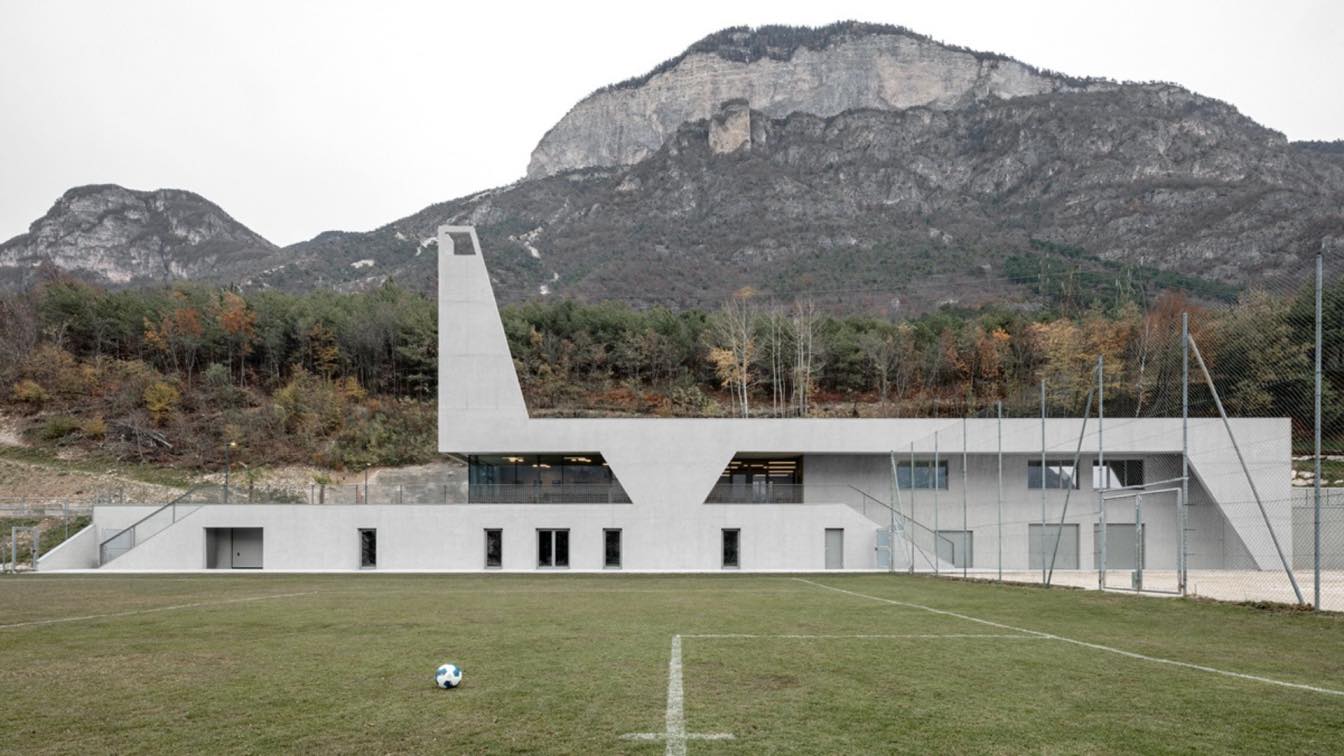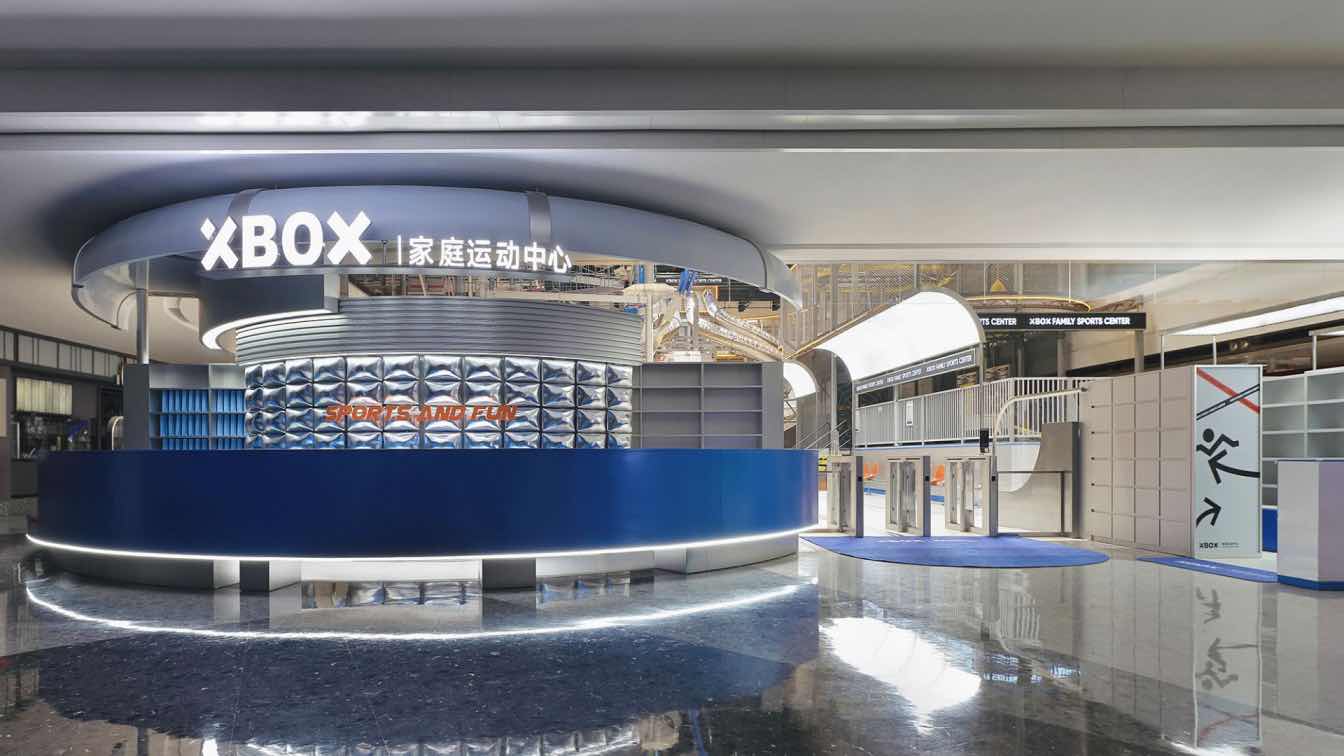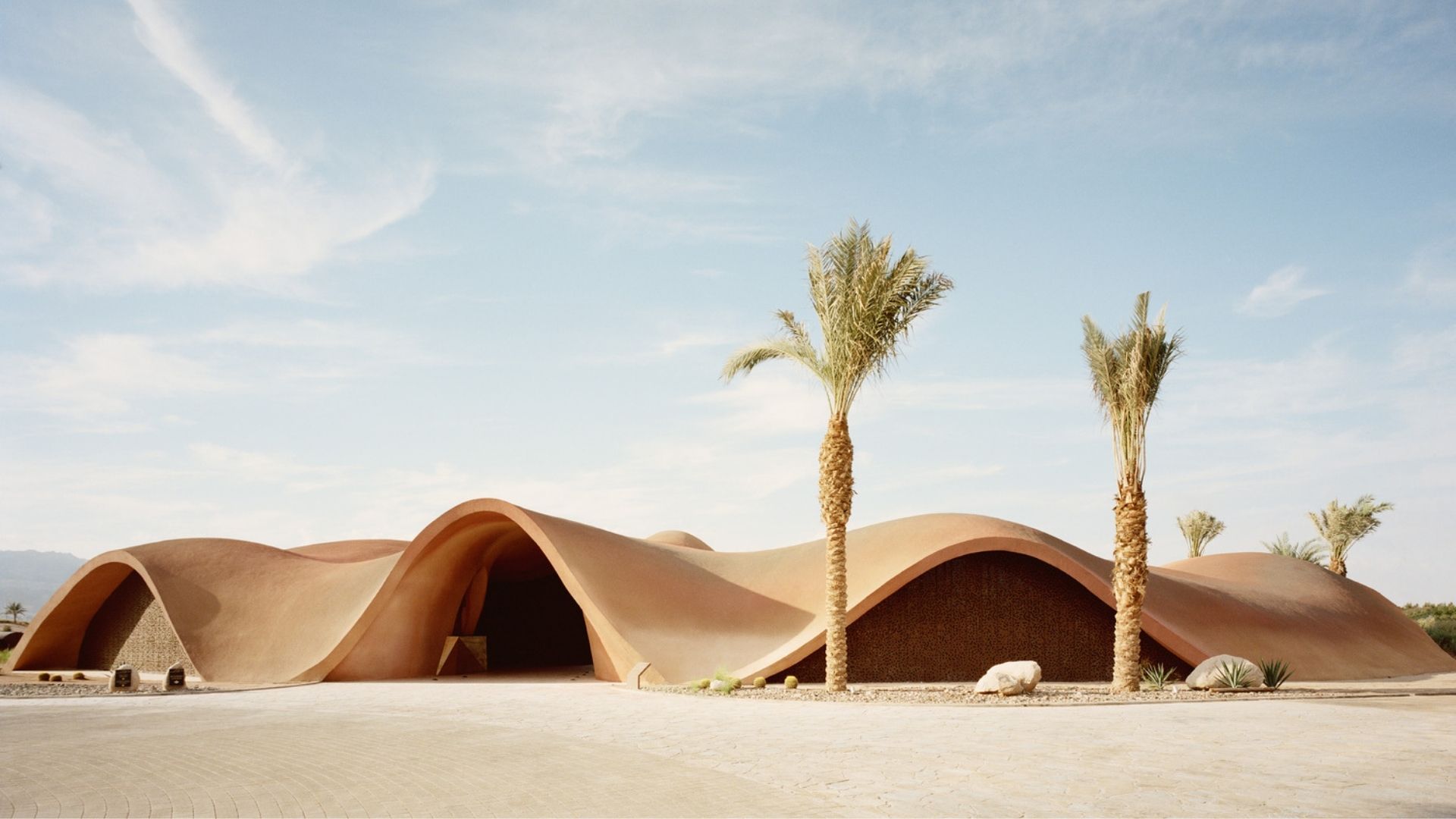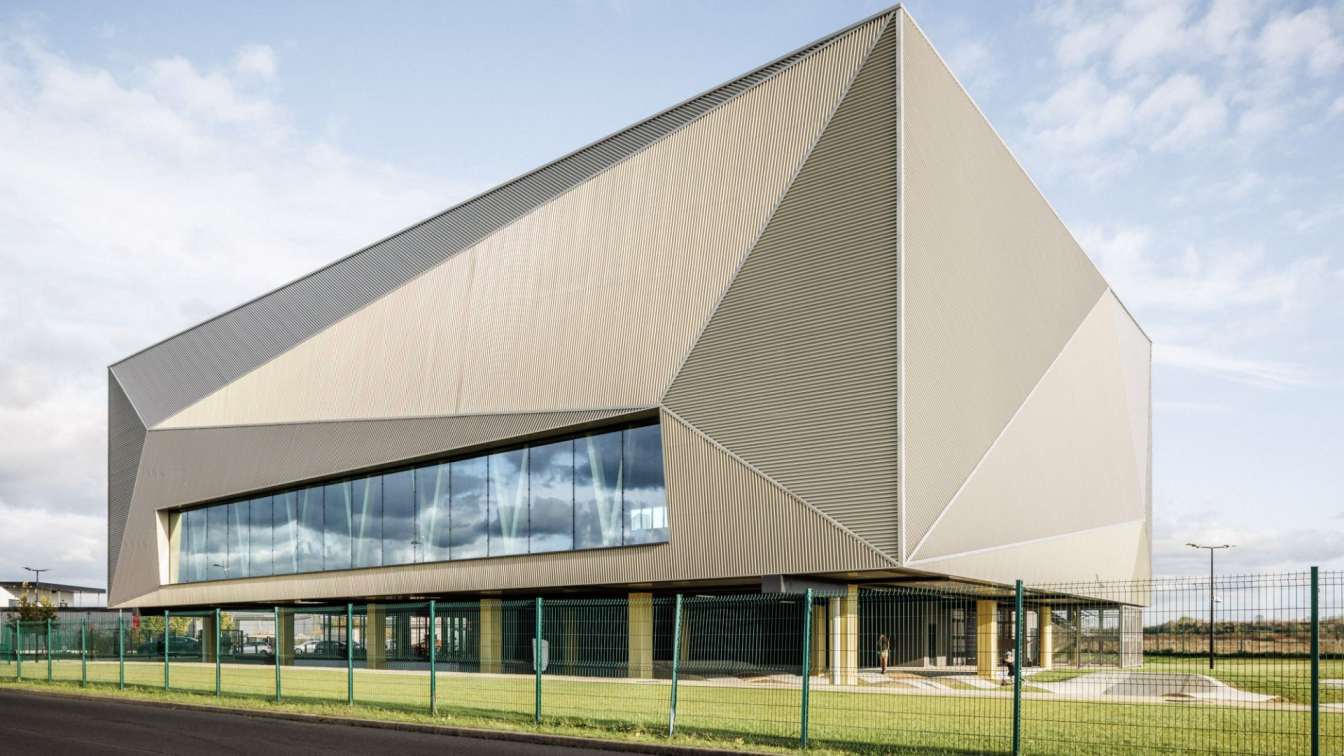With the Fieldhouse project, architecture office MoDusArchitects inserts a new material milestone into the South Tyrolean landscape with inclusive spaces dedicated to sports and recreation.
Located in the small town of Laghetti (Egna Municipality, Bolzano) nearby the riverbanks of the Adige river, the building sits at the foothills of Mount Corno whose natural reserve park forms a dramatic backdrop to the sports facility.
Infrastructural in character, Fieldhouse is wedged between a five-a-side football pitch to the north, the existing football field to the west and the steeping terrain to the east. With its low-lying body that transforms as it moves laterally along the site, Fieldhouse mutates from a retaining wall to a long linear roof to then become a raised groundscape that acts not only as a viewing platform for sporting events, but also as an outdoor venue for social occasions.
MoDusArchitects, appointed to demolish the old building that housed the changing rooms and the sports association, proposes a new building with an extension that would improve the building's energy efficiency while reusing the existing photovoltaic system.
Be it football pitch, tennis courts, or baseball diamonds, outdoor recreational fields are precisely constructed landscapes: their shape, size, edges, and orientation on the site are regimented by the rules of the game that they host.
— affirms Matteo Scagnol, co-founder of MoDusArchitects.

In many ways Fieldhouse is a connector piece, part of the larger puzzle of small-town settlements that line the valley basins of South Tyrol: residential neighbourhoods, light-industrial zones and sports infrastructures sit side-by-side in limited swathes of land. Positioned at the point of inflection between valley and mountain, Fieldhouse is characterized by a regular and elongated plan, while also providing a bold geometrical profile in elevation that measures itself up against the vertical landscape. In section, Fieldhouse mediates the topography with two levels that connect up the various programs and vista points.
Fieldhouse becomes a new community hub dedicated to sports, but also to recreational activities:
"We wanted to give the community a project that was accessible and would grant full visibility to all the activities of the functional programme, especially those aimed at the public and spectators. This sparked the decision to position the volume longitudinally, to accompany visitors in the enjoyment of their leisure time, thereby creating a new social space."
— continues Sandy Attia, co-founder of MoDusArchitects.

The two-storey structure, one partially underground and one above ground with an adjoining large terrace, is made of reinforced - exposed concrete cast in situ. The glazed apertures take cue from the geometries and slopes of the site, forming a uniform envelope punctuated by alternating trapezoidal pillars and sharp cuts at the openings.
On the east side, a lighting tower reaching towards the sky, 11-metres high and tapering upwards, acts as a counterweight to the extended body of the Fieldhouse. It incorporates the requisite lighting poles into an architectural element that delineates the outermost corner of the building—a hinge between built volume and the ground—to become a visual marker in the landscape.
The tower is an integral part of the roofscape whose long, flat roof houses the 52 photovoltaic modules. Thanks to a system that covers 50% of its energy consumption with renewable sources, the new building is CasaClima A certified.
From the entrance forecourt, a wide panoramic covered staircase leads to the first floor which hosts the caretaker's apartment, offices, a meeting and teaching room, the cafeteria area and kitchen with indoor and outdoor dining areas, and a large terrace for parties and public meetings.

The ground floor houses the new changing rooms with showers and toilets for 30 players, with a direct connection to both the football pitch and the inside of the building.
Here in addition to the storage facilities for the sports equipment is located the independently operated, local division of the Tiroler Schützen with a small indoor shooting range and dedicated storage area. The association is rooted in the local culture of South Tyrol and once constituted the former voluntary army.
The design of the Fieldhouse by MoDusArchitects reflects on the architecture of local sports facilities and their public character, tracing the outlines of a typology little explored on the Italian scene.
The relevance of the Fieldhouse for the local community elevates the functional nature of the sports field and generates an inclusive space where sports-centred services merge with recreational spaces that the entire local community can enjoy.











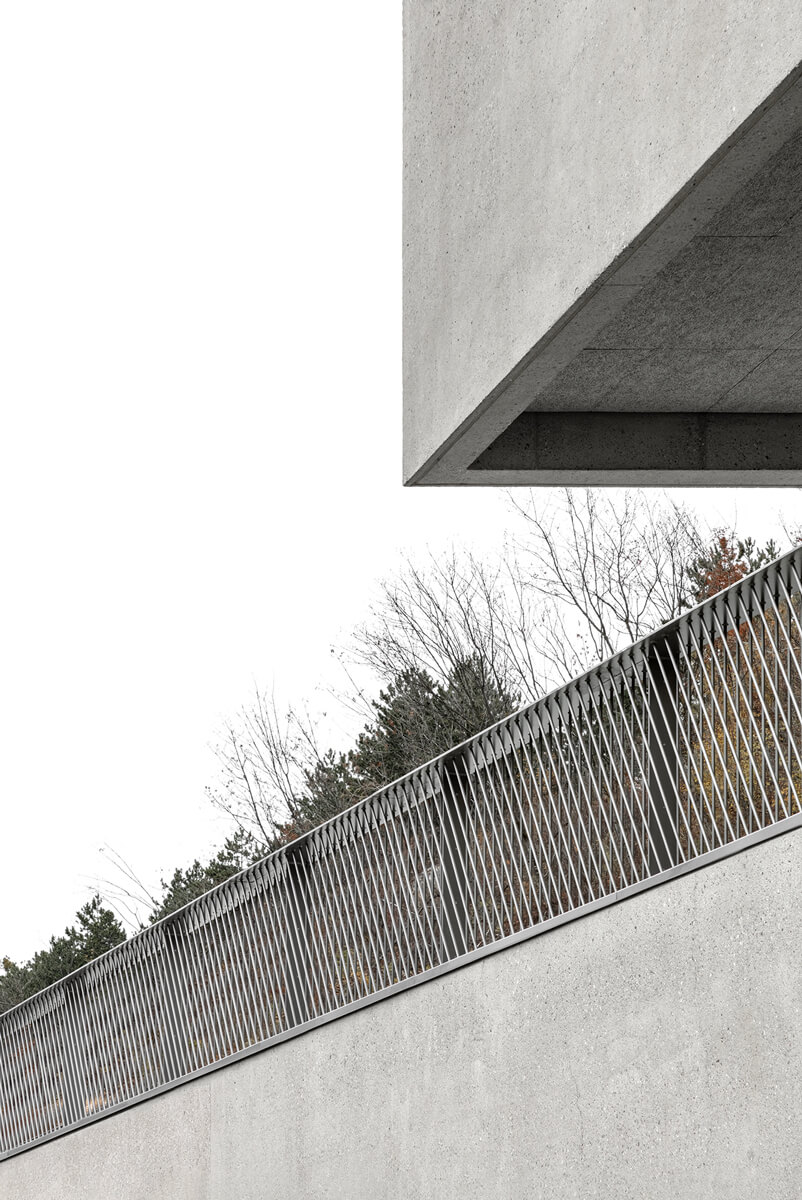













About
MoDusArchitects was founded by Sandy Attia (Cairo, 1974) and Matteo Scagnol (Trieste, 1968) in 2000. The studio distinguishes itself within the international architectural panorama by the bold and heterogenous body of work that intertwines the founding partners’ two different formative and cultural backgrounds.
Since its inception, MoDusArchitects addresses multiple topics, scales and programs – from infrastructure to school buildings – and pursues a design process that holds steadfast the relationship between ideas and buildings. The projects are careful studies of the places and contexts within which they are situated to produce surprising architectural vocabularies that combine an approach that is both intuitive and grounded in the tectonics of the architectural discipline.
Completed works include the Novacella Abbey Museum Addition, the renovation and extension of the Cusanus Academy, TreeHugger - Bressanone Tourist Visitors Centre, the Bressanone-Varna ring road, Ponte di Ghiaccio Mountain Lodge, the Psychiatric Rehabilitation Centre, the School Campus in the Firmian district of Bolzano, the Bressanone-Varna Ring Road, the Kostner House and Studio, the Damiani Holz&Ko Office Addition, the Hotel Icaro’s extension and several private single family house projects.
MoDusArchitects’ work has been recognized with a number of important awards: the Premio italiano di Architettura 2022, In/Architettura award 2020, Best Architects (2013, 2018, 2019), German Design Council’s Iconic Award (2012, 2019), the first prize for the International Piranesi Award 2013 and the jury’s special prize at the Premio Architetto Italiano 2013; honourable mentions for the Premio Architettura Città di Oderzo 2022, the Gold Medal in Italian Architecture (2015, 2012), the Architetto Italiano Prize 2021 and the Premio italiano di Architettura 2020; a nomination for the EU Mies van der Rohe Award 2015 and two nominations for the EU Mies van der Rohe Award 2022 (TreeHugger and Cusanus Academy).
Several projects have been included in the Triennale di Milano in 2012 e 2015, the Venice Architecture Biennale in 2010, 2012, 2014 and 2018 within the Italian Pavilion.
The Kostner House and Studio project together with the Damiani Holz&Ko Office Building project are part of the MAXXI Museum’s permanent collection in Rome.
Matteo Scagnol and Sandy Attia flank their professional work with their academic roles as Visiting Professors at the University
of Virginia (USA) and previously held the same role at Princeton University (USA). Sandy Attia also leads an architectural design course at the Milan Polytechnic.

